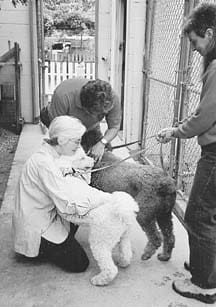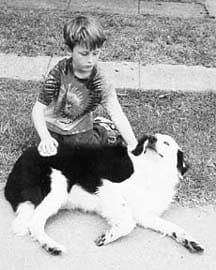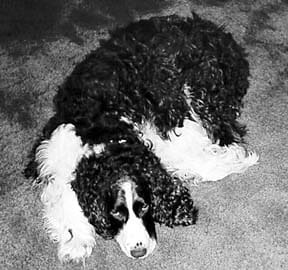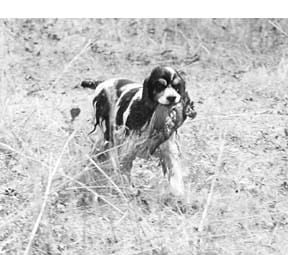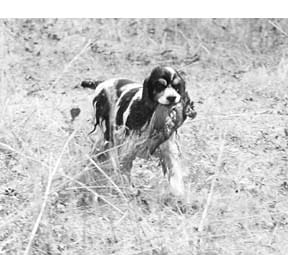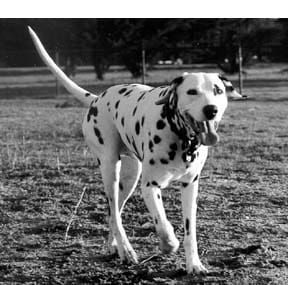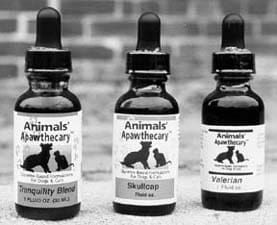[Updated January 28, 2019]
In conventional veterinary medicine, cancer treatment for dogs consist primarily of surgery, chemotherapy, and radiation. While research in these areas has brought significant advances, the overall picture is discouraging; cancer death rates are largely unchanged. While many canine cancers are treated successfully when diagnosed early, more often the therapies, conventional or holistic, simply buy some additional time for the animal. In standard canine treatment protocols, a 12-month remission is considered a “cure.” While a year of dog’s life is a relatively long time, one should read between the lines of such semantics.
In recent years, however, researchers are increasingly looking at the probable underlying causes of cancer, and utilizing alternative treatments such as Chinese medicine, cancer-fighting diets and nutritional supplements. Evidence suggests that these are valuable, and sometimes highly effective, tools.
Even the American Veterinary Medical Association has cautiously moved forward on the issue. The preamble to the current AVMA Guidelines states:
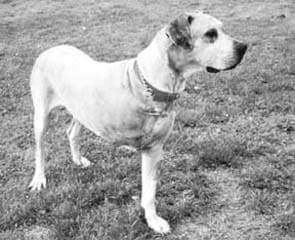
“Veterinary medicine, like all professions, is undergoing changes with increasing rapidity. Additional modalities of diagnosis and therapy are emerging in veterinary and human medicine. These guidelines reflect . . . a comprehensive approach to the healthcare of non-human animals.”
In other words, mainstream veterinarians are coming to appreciate the holistic model, if not necessarily all of the holistic therapies themselves. At the same time, legitimate alternative veterinarians do not possess a reliable, systematic cure for any type of cancer, and responsible practitioners should inform you about all treatments – conventional and otherwise – having the highest rates of success. They should also inform you about the rates of failure, and about the side effects of the treatments.
If your dog has a life-threatening cancer, there are basically only three outcomes: an acceptance that little can be done beyond maximizing quality of life for the time remaining (palliation), extending the dog’s quality life beyond what would normally be expected with a given course of treatment, or eliminating clinical symptoms for an extended period, up to and including the natural end of a dog’s life. The first two scenarios, unfortunately, are far more common than the third.
Conventional veterinary medicine tends to focus on treatments meant to eliminate the dog’s tumors. Alternative veterinary practitioners focus more on the underlying disease triggers, prescribing natural treatments that help optimize immune function (because this enhances a dog’s chance of keeping cancer under control), and, at the same time, maintaining a better quality of life than is otherwise possible.
There is a big difference in philosophy between these two camps, but one similarity is striking: The treatment protocols of each are most successful in the earliest stages of the disease, and with young dogs with otherwise vigorous immune systems. All veterinarians, holistic and otherwise, get worn down by the professional challenge of treating dogs with advanced cancers that they could, and should, have treated earlier.
There is no perfect answer to the question of “What do you do next?” Will you try to “cure” the dog of cancer? Or is “quality of life” the goal? Treatment decisions involve a complex and emotional set of options, which may be limited by where you live, the range of veterinary resources available, the age of the dog, and the money you are willing or able to spend.
Conventional Cancer Treatment for Dogs
What follows is a brief overview of the standard protocols, as well as the most promising areas of research, in conventional medicine; and a review of holistic veterinary philosophy, which in many cases is probably as effective, and certainly less invasive than conventional treatments.
Surgery
When it comes to canine cancer, a tumor that can be cleanly excised is the best possible news. For certain malignant tumors, caught early, it provides what is still the best hope for a lasting cure. Unfortunately, it is often difficult or impossible to remove tumors completely.
Radiation Therapy
In these treatments, a series of directed bursts of radiation, more powerful than x-rays, neutralize the cancer cells at which they are directed. This treatment can be highly effective in controlling localized tumors. It is also used as an adjunct to surgery in which tumors evade total removal, and is sometimes prescribed prior to other treatments to reduce a tumor’s size. Radiation therapy is a valuable, if limited tool, given the long-term risks and side-effects of the treatments. It destroys normal cells in addition to the cancerous cells, so for any given dog, the ability of surrounding tissue to heal may be seriously impacted. In addition, it requires a major commitment in terms of time and expense. A typical program entails 12 treatments over four weeks.
Chemotherapy
In general, chemotherapy (treatment with drugs) has not yet lived up to its early promise. This is because, in the simplest terms, it is an unfocused strategy which attacks all fast-growing cells, including those of the immune system. Also, as a tumor grows and spreads, there exists a high probability of concomitant cell growth resistant to whatever chemotherapy is applied to it – and, meanwhile, the patient is often left vulnerable to other diseases.
But chemotherapy is anything but a dead-end science. There is an enormous amount of research underway, particularly in the field of immuno-targeted drugs, designed to specifically seek out only cancerous cells, reducing or eliminating chemo’s signature compromise of a patient’s immune system. These drugs, at the research and development testing stage, might soon play an important role in comprehensive cancer treatments. In current clinical usage, however, canine chemotherapy has a limited value; it works great when it works, and fails spectacularly when it fails. Some ultimately fatal cancers, like lymphoma, respond particularly well to current chemotherapy protocols, often adding many worthwhile months to a dog’s life.
On the other hand, for many types of cancer, this invasive and toxic protocol simply doesn’t work very well. Many dog owners call a halt to aggressive chemotherapy treatments simply because – with little chance of remission – they can’t stand seeing their dog suffer though the common side effects: nausea, lethargy, diarrhea, loss of appetite, and disinterest in former pastimes, among others. Thus, unless a cure is believed highly likely, veterinarians tend to prescribe far lower proportional doses and fewer drug combinations than would be considered maximally effective.
To complicate matters, sometimes, as we’ll see below, standard chemotherapy functions at direct cross-purpose to some of today’s most promising research.
Cancer Research
A partial list of this research includes work on genetic triggers, heredity, hormones, protein synthesis, virology, tumor markers, suppressor genes, as well as more conventional research in nutrition, environmental toxins, photodynamic therapy, and cryotherapy (freezing tumors with liquid nitrogen).
In the future, this work seems likely to bring about revolutionary advances to all phases of cancer research: Prevention, detection, diagnosis, and treatment. There will be more vaccines against certain cancers (witness the feline leukemia vaccine), protection for those at hereditary risk of cancer, genetic engineering that will predict and control those factors causing cells to mutate, and the ability to identify and screen microscopic cancerous growths, allowing far earlier intervention.
Below are a few of the latest therapies either in use or under development. Keep in mind that much of this research is likely to benefit our dogs only in the future:
Photodynamic therapy
Laser therapy shows promise in a number of surgical procedures requiring very precise application. Just as targeted gene therapy is likely to supersede standard chemotherapy in the coming years as the treatment of choice for systemic cancers, more sophisticated laser therapy might replace radiation in treating some localized tumors. In photodynamic therapy, or PDT, the patient is injected with a light-sensitive agent which precisely marks the tumor. It is then possible to apply the laser with minimal damage to surrounding tissue. Among the advantages over radiation, it is often a one-time treatment, less expensive, less intrusive for the patient, and less time-consuming for the pet owner.
Bone transport
Osteosarcoma accounts for some 80 percent of the primary bone tumors found in dogs. Nicole Ehrhart, a veterinarian and surgical oncologist at the University of Illinois, is researching techniques that might eventually eliminate amputation as the treatment of choice in some early-stage bone cancer patients. This technique, known as bone transport, allows the dog’s own body to mediate repair.
In this procedure, after the surgical removal of the cancerous part of the limb, a cross-sectional piece of the patient’s normal bone is moved into place, held by what is called an Ilizarov brace (named for the scientist who invented it). Because it is the patient’s own bone, and with a blood supply in place, the body responds as if to a fracture. The brace is moved as the bone heals naturally behind it; when the new bone structure is complete, the brace is removed.
While this technology has been used for some time in human accident victims, a two-year study has shown that the technique can be used in conjunction with chemotherapy, a major concern in whether the procedure could be effective for cancer patients.
“Chemotherapy attacks all fast-growing cells,” Dr. Ehrhart said, “and our concern was that this might slow or even prevent new bone growth. We found that chemotherapy initially slows the healing process, but bone growth catches up.” It should be emphasized that, while promising, this technique remains experimental. Ehrhart believes the procedure might move into the surgical mainstream in three to four years. While the healing process takes time, on a practical level, perhaps the best news is that the brace does not prevent most normal canine activities.
Immunotherapy
This treatment is familiar to anyone who’s ever had an allergy shot. Basically, it manipulates, or “tricks” the immune system into protecting against specific infectious agents. There is a great deal of research underway in this field, and reason to hope that in the not-too-distant future, veterinarians will be able to regulate our dogs’ immune system to attack the specific characteristics of specific cancers.
One area of this research involves genetically engineered vaccines for melanoma and several other types of cancer. Cancer begins when the immune system is unable to identify or destroy cancerous cells. Vaccines might effectively utilize the fact that melanoma, for example, carries unique antigens (shorthand for antibody-generating) on the surface of its cells. In current experiments, these antigens are altered and re-injected into the tumor, triggering the body’s own T-cells to attack it. In addition these are true (though still experimental) vaccines in that they “train” the body’s existing immune “memory” cells to imprint the identity of the cancerous cells and continue to attack them. Results are promising enough that large-scale trials are planned.
In a related strategy, researchers at the University of Michigan have genetically engineered monoclonal antibodies (normal cancer-fighting lymphocytes fused to cancer cells) to attack non-Hodgkin’s lymphoma, a cancer similar to the lymphosarcoma common in dogs. Another class of these bio-therapeutic drugs seeks to block the production of cancer-causing proteins. This involves a strand of laboratory-engineered DNA bound to a strand of messenger RNA (which triggers production of the proteins) found in solid cancerous tumors, thus slowing growth of the protein-dependent malignancy.
Yet another class, called anti-angiogenesis drugs, recently caused a media frenzy when it was reported in the New York Times that the drugs had caused tumors in mice to disappear. While researchers were quick to point out that animal testing often fails to translate into human results, the drugs, called angiostatin and endostatin, attack cancer by blocking the growth of blood vessels that allows it to grow.
Finally, there is gene-therapy itself, which is the actual correction of genetic errors. Cancer is a disease of defective or inoperative genes; in cancer patients, those genes which block cancerous cell replication cease to function effectively. In one branch of research, the body’s own immune cells are altered for specific results. In another, the engineered tumor-suppressing genes are injected into a tumor, and begin to multiply, stopping the unregulated cell growth that makes cancer lethal.
While researchers believe that true cancer cures will eventually come from these areas of research, these experimental strategies remain only that.
Holistic Cancer Therapies
Research into high-tech cures for cancer is promising, but equally exciting is the world of holistic treatments, a broad, humane and promising world of veterinary practice. It could be argued that conventional medicine has been more informed by a holistic vision of the cancer patient than in any other type of disease treatment. In cancer research, there are a number of interrelationships at work, the most powerful of which is the fact that one quarter of the chemotherapeutic drugs currently in use are plant-derived; what is called natural chemotherapy is one of the hottest areas of cancer research.
According to the World Health Organization, the plants used in most modern plant-derived medicines have a history of use in so-called folk remedies. Drug companies are now searching this natural worldwide pharmacy for possible medical and commercial uses. (Indeed, there is even a scientific sub-discipline called zoopharmacognosy – the study of those plants which animals instinctively search for when they are sick.) In short, the holy grail of medicine – a cure for cancer – could be growing in some remnant forest, unknown to science.
But while holistic medicine may be able to cure your cancer-stricken dog, the treatment responsible for the cure may be impossible to replicate. Holistic medicine is based on the sum of a pet’s individual circumstances. Given 10 dogs with the same type of cancer, a holistic veterinarian might prescribe 10 different courses of treatment. Such methods do not fit well into scientific, double-blind, randomized studies.
When a dog owner asks, “What is the best possible outcome for my dog – in the context of my individual circumstances – and how will my dog and I get there?,” informed veterinarians can only offer the following options for the owner to consider:
Nutrition
The subject of nutrition – specifically, cancer-fighting diets – confronts the dog owner with bewildering choices. As we all know, nutrition is a staple of the canine press, yet the science behind nutrition is so complex as to be incomprehensible to most veterinarians, let alone ordinary dog owners.
Nutrition is a field where “facts” rise and subside like so many mayflies. Nutritional factors (megavitamins, for example) might benefit one dog, but, in certain circumstances, be harmful for others; yet precisely how nutrients affect cancer, in the crucial context of maintaining general health, is a frontier of science.
But meanwhile, if your dog has cancer, “improved nutrition” is the theme of every holistic cancer therapy, and increasingly an integral part of mainstream protocols.
Due to the extensive research available on the subject of diet and neutraceutical therapies for cancer, next month, WDJ will devote an entire article to the subject, along with several “anti-cancer” diets recommended by canine nutrition experts and veterinary oncologists.
Homeopathy
In homeopathy, external symptoms are considered indicative of a deep systemic “energy imbalance” in need of correction. The discipline employs an array of natural substances, in often vanishingly minute doses, which mimic disease symptoms, thus triggering an immune response. The perennial question of how such extreme dilutions could possibly retain any disease-fighting force might well have an answer in quantum physics.
But while the number of veterinarians practicing homeopathic medicine is on the increase, and every homeopath can offer anecdotal evidence of cancer cures due to homeopathy, double-blind, scientific studies have not demonstrated homeopathy’s benefit to canine cancer patients.
Traditional Chinese Medicine
Along with acupuncture, traditional Chinese Medicine, or TCM, is the Western world’s most widely used and widely respected alternative medicine; the Harvard Medical School, for example, has long had an exchange program with the national Chinese medical academy.
Chinese medicine considers cancer to be the ultimate expression of immune imbalance. In TCM, disease is understood to be caused by disturbances in a complex systemic energy flow called qi, which courses through the body on a network of meridians, each of which is associated with a major organ and with highly receptive acupuncture points. All of which merely hints at a complex terminology relating to a sick individual’s physical and psychological state, which TCM practitioners call a “pattern of disharmony.”
Chinese medical practitioners do not claim any extraordinary ability to cure cancer, canine or otherwise, although many of their herbal therapies have proven cancer-fighting properties. TCM stresses prevention – that diet, exercise, and positive mental health can prevent cancer by correcting these imbalances before they cause disease.
Acupuncture neither prevents nor cures cancer, but it is now widely used – among many other benefits – to relieve the side effects of chemotherapeutic drugs, and to boost immune function. In Western terminology, acupuncture (in which needles and/or targeted heat, suction, electrical impulses, lasers, and other techniques, may be employed) achieves its effects by altering chemical neurotransmitters in the body, triggering the release of pain-killing hormones, natural steroids, and endorphins.
At Colorado State University’s School of Veterinary Medicine, acupuncture is well-accepted and often used in the cancer wards.
Unconventional therapies
There are any number of other unconventional cancer therapies whose proponents claim some level of cancer-fighting efficacy. However, all are clinically unproven treatments, which tend to be sought by those for whom conventional medicine offers no further hope. To name just a few, these therapies include shark cartilage, chelation therapy, blood and urine derivatives called antineoplastons, Iscador (a fatty extract of the mistletoe plant), laetrile, vitamin C, and hydrazine sulphate.
It is worth repeating that what cures (or seems to cure) cancer in one dog might not cure another; of course, this is true of conventional medicine, too. However, if there were in fact a highly-effective, systematic cure – for any type of cancer – among these unconventional treatments, it is safe to say that you would already know about it.
Chiropractic and massage
Chiropractic is a valuable healing tool, but has not proven to be useful for treating cancer. Dr. Gregory Ogilvie, a veterinary oncologist and professor at Colorado State University, characterizes the modality this way: “While good data exist concerning the efficacy of this treatment discipline, few data exist involving the cancer patient. . . Chiropractic care for the veterinary cancer patient revolves primarily around improving function and reducing pain, especially in areas of orthopedic or neurologic disorders.”
The report on massage therapy for cancer patients looks similar. While the treatments have been shown to be useful for relieving some of the side effects of cancer (and the cancer treatments) such as pain, inflammation, soft tissue dysfunction, epileptic seizures, anxiety, and depression, there is no evidence that massage can slow cancer growth. And in fact, for certain cancers, increasing the patient’s blood flow may assist the cancer’s spread. Discuss this concern with your veterinarian before using this modality on a dog with cancer.
The Bottom Line
One of the principles that the caregiver for any cancer patient should be aware of is that there is an often-rancorous battle between conventional and alternative veterinary practitioners when it comes to cancer. Your veterinarian may choose not to take a side in the fight, or he may be a strident advocate for his side. But your own cancer strategy can best be directed from neutral ground. Simply put, the best veterinarian for your cancer-stricken dog is one who looks for treatments that work, one who sees beyond the conventional, linear cancer-treatment model – whether that be the straight “alternative” approach or the straight conventional approach. The most successful practitioners work from a “whole dog” perspective.
In addition, it seems clear that any cancer-stricken dog is likely to benefit from therapies such as acupuncture, enhanced dietary programs, herbal medicine, not to mention simple love and affection; as a healing tool, of course, love is considered an “alternative” notion by many scientists. Perhaps it is. But beyond love, there are no definitive answers, only calibrated options and informed hope.
Roger Govier, a freelance writer and frequent contributor to WDJ, lives in San Francisco, California.


